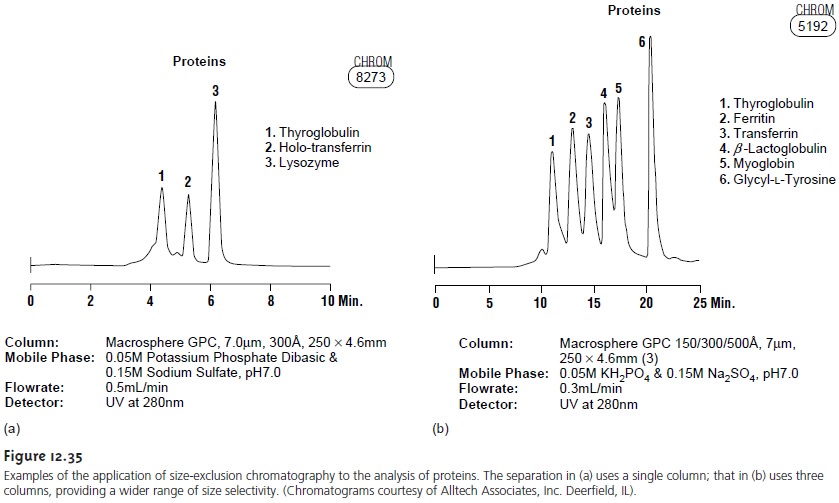Chapter: Modern Analytical Chemistry: Chromatographic and Electrophoretic Methods
Size-Exclusion Chromatography
Size-Exclusion
Chromatography
Two classes of micron-sized stationary phases have been encountered in this sec- tion: silica particles and cross-linked polymer resin beads. Both materials are porous, with pore sizes
ranging from approximately 50 to 4000 Ă… for silica particles and from 50 to 1,000,000 Ă… for divinylbenzene cross-linked polystyrene resins.
In size-exclusion chromatography,
also called molecular-exclusion or gel-permeation chromatography, separation is based on the solute’s
ability to enter
into the pores
of the column packing. Smaller solutes spend
proportionally more time
within the pores and, consequently, take longer to elute from the column.
The size selectivity of a particular packing is not infinite, but is limited
to a moderate range.
All solutes significantly smaller than the pores move through the column’s entire volume and elute simultaneously, with a retention volume, Vr, of
Vr = Vi + Vo
……………..12.32
where Vi is the volume of mobile phase occupying the packing material’s pore space, and Vo is volume of mobile phase in the remainder of the column. The maxi- mum size for which equation 12.32 holds is the packing material’s inclusion limit or permeation limit. All solutes too large to enter the pores elute simultaneously with a retention volume of
Vr = Vo ……………..12.33
Equation 12.33 defines the packing
material’s exclusion limit.
In between the
inclusion limit and
the exclusion limit,
each solute spends
an amount of time in the pore space
proportional to its size. The retention volume
for a solute is
Vr = Vo + DVi
……………..12.34
where D is the solute’s distribution ratio, which ranges
from 0 at the exclusion limit to 1 at the inclusion limit. The validity
of equation 12.34
requires that size exclusion
be the only interaction between
the solute and the stationary phase responsible for the
separation. To this end, silica
particles used for size exclusion are deactivated as described earlier, and polymer
resins are synthesized without exchange sites.

Size-exclusion chromatography provides a rapid means for separating larger mol- ecules, including polymers and biomolecules. Figure 12.35 shows
the application of size-exclusion chromatography for
the analysis of protein mixtures. In Figure
12.35a, a column packing with 300 Ă… pores, with an inclusion
limit of 7500 g/mol and an exclu- sion limit of 1.2 x 106 g/mol, is used to separate a mixture
of three proteins.
Mixtures containing a wider range of formula weights can be separated by joining
together sev-
eral columns in series. Figure 12.35b shows an example
spanning an inclusion
limit of 4000 g/mol and an exclusion limit of 7.5 x 106 g/mol.
Another important application is for the determination of formula weights.
Calibration curves of log(formula weight)
versus Vr are prepared
between the exclu- sion limit and inclusion limit (Figure 12.36).
Since the retention volume is, to some
degree, a function of a solute’s size and shape, reasonably accurate
determinations of formula weight
are possible only
if the standards are carefully chosen
to mini- mize the effect of shape.

Size-exclusion chromatography can be carried out using
conventional HPLC instrumentation, replacing the HPLC column with an
appropriate size-exclusion column. A UV/Vis detector is the most common means
for obtaining the chromatogram.
Related Topics